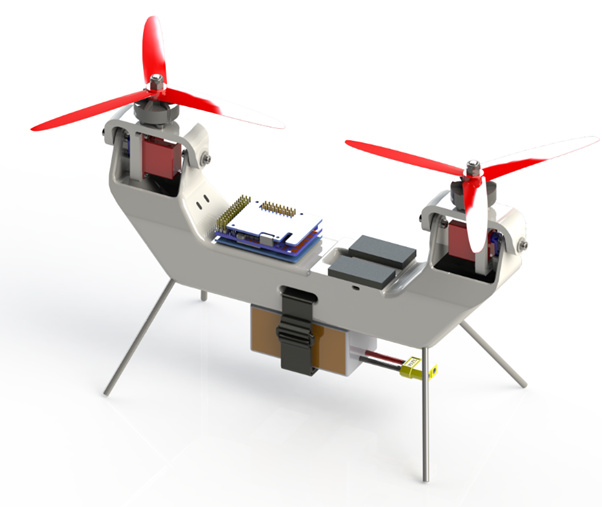Hi Lupus, found these comments from some years back the link Jason Clark gives to Zippyshare.com has gone? Thought could try this code in Chinook model (none twin coax motors)…Is it possible to reach (trouble) Jason for his code from this forum?
Regards Charles
Bicopter - The journey so far
Jul 2020
5 / 30
Aug 2020
Jul '22
A little while ago I posted a blog about a coaxial copter design and build (https://discuss.ardupilot.org/t/design-and-build-of-a-coaxial-drone) that turned out to be quite the handful when it came to tuning. The main reason for the difficulties I was facing was the gyroscopic forces involved in tilting a motor/prop combination to do thrust vectoring. The next logical step was to move to a design in which these gyroscopic forces from one motor/prop are (mostly) cancelled out by equal and opposite gyroscopic forces of the other motor/prop.
The design I settled on was this bicopter, similar to a V22 Osprey, the layout of which is supported in Arducopter. The control system is pretty self-explanatory; to pitch forward, the servos tilt both motors forward; to roll left, the right motor increases in rpm and the left motor decreases; to yaw left, the right motor tilts forward and the left motor tilts rearward. There are some control characteristics which make tuning such a layout a little tricky though:
- Rolling the drone causes unequal thrust and therefore unequal torque of the motors, resulting in a slight yaw.
- Pitching the drone forward doesn’t invoke any gyroscopic forces on the airframe because the gyroscopic forces from the right hand motor are cancelled out by the gyroscopic forces of the left hand motor. However, when yawing, the gyroscopic forces combine instead of cancel, resulting in a slight roll of the aircraft. I have found this effect to be negligible though.
- There is some other cross-coupling of pitch/roll/yaw if the drone isn’t balanced correctly but I won’t go into details.

The design of this drone isn’t quite as polished as my previous efforts as I wanted to prove the concept out a little more first. However, I will still post all the files including 3d printable files, parameters and parts lists up to now here: https://www44.zippyshare.com/v/ud56Dksx/file.html
So far I’ve put about 6 packs through it and this is the performance I’m seeing:
Next steps will be:
- More tuning
- Reduce vibrations
- Move to Chinook configuration from current Osprey configuration
- Install GPS + compass and start using more autonomous flight modes
- Install FPV camera and transmitter
18
Reply
![]() Jul '20
Jul '20
- [
last reply
](Bicopter - The journey so far - #31 by manbehindthemadness)
![]() Jul '22
Jul '22
- 29
replies
- 7.1k
views
- 11
users
- 24
likes
- 9
links
rmackay9Developer
That seems to be flying really well! nicely done!
Reply
Thanks Randy! This is an outdoor flight from today: https://www.youtube.com/watch?v=tsZDdXIjgkM
Understandably the pitch is proving by far the most difficult axis to tune - even with notch filtering on the system instability (25Hz) I’m not able to raise kP or kD high enough to get the tune very crisp. What I’m finding is that I’m having to run quite high kI values to compensate which is causing some unwanted behaviour, especially in dynamic or windy flight.
So next steps are:
- Investigate the use of the feed-forward (ATC_RAT_PIT_FF) to supplement P, as in the heli code
- Convert to Chinook layout, as a good pitch tune is more valuable for the kind of flying I do than a good roll tune.
- Look into changing to an Oblique Active Tilting design (http://www.reports.ias.ac.in/report/21006/stability-and-control-of-vtol-tilt-rotor-bi-copter-uavs ), whereby the action of tilting the props forward also imparts a gyroscopic torque on the airframe. I expect the pitch response to benefit quite a bit. A video of an OAT bicopter can be found here: https://www.youtube.com/watch?v=usiaKOpi4kE
2 Replies
1
Reply
iampetePeter HallDeveloper
Great to see bicopters getting some love!
I found lowering the GC as much as possible helps, this has the effect of ‘speeding up’ the servos. A smaller movement gives same amount of thrust vectoring moment.
Front and back ‘chinook’ bicoipter layout is not currently sported.
I looked into OAT a little, I suspect it wont work that well on a smaller scale due to size/weight of the props. If I recall correctly they can also the saturate gyroscopic effects and suddenly become a normal bi-copter.
2 Replies
Reply
Hi Peter, thanks for the feedback.
I’m still tossing up whether to go the OAT route, on the one hand as you’ve correctly said the inertia of the motor bell and prop is reduced at this scale, but the total aircraft inertia also scales down by a similar proportion.
Interesting point on gyro saturation; you’re right that no movement of the props = no gyroscopic force. I don’t expect that to be a problem though because the gyroscopic torque will just be in addition to the tilt-rotor torque and not a replacement of that torque.
All speculation of course and I could always do some calculations and modelling but building one to test would be more fun ![]()
